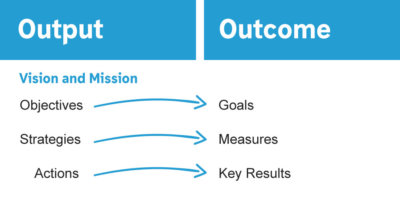A bake-off between OKR & OGSM strategic methodologies
Benefits of a methodology
Using a methodology as the framework from which you approach the execution of strategic thinking can be extremely helpful. It offers a proven approach to strategy implementation and provides a standardized method which is consistent across the enterprise. This, in theory, will lead to a better understanding of the strategic plan by focusing people on what is strategically important–generally described as the vision and mission (or “vision and purpose”): the overarching, figurehead statement that is the point of convergence for all strategic activity.
OGSM and OKR
There are many methodologies that could provide value: Balanced Scorecard (BSC), Management by Objectives (MBO), Hoshin Planning, etc. They all have their strengths and weaknesses; however, I would like to discuss two that are similar but different. These two have withstood the test of time and continue to gain traction and acceptance: Objectives, Goals, Strategies and Measures (OGSM) and Objectives and Key Results (OKRs).
Defining the variables
Terminology can be challenging when the words used can mean different things to different people, and are used in a different context within the different methodologies. This is quite apparent when comparing OGSM and OKR, the “O” while describing activity is subtly different. But we can use the term “objectives” to describe something that we or I will do, “objectives” therefore are a product of delivery; they are subjective in that it is a rating of a person(s) confidence or progress. Broadly speaking “goals” and “measures” (in the case of OGSM) and “key result areas” (in the case of OKR) allow us to monitor an outcome numerically (and using milestones in the case of OGSM), often described as a metric or key performance indicator (KPI). That leaves strategies, in OGSM strategies are a decomposition of objectives into specific directed strategic pieces of work. Again the term key result areas (KRA) is often used, and they are the tactical actions, the where, what, when and how statements.
High-level comparison
Both methods seek to align the efforts of people with the vision of the organization, while constantly measuring success or failure. Simply put, they measure output and monitor outcome, but where they differ is the level in which they are deployed. OGSM lends itself to top-down enterprise-wide goal setting, strategic planning and execution, and OKR offers a solution for individual or team level goal setting and execution. They both utilize a hierarchical view of delivery, they both encourage the linkage of output to outcome at each level, and they both involve teams of people and communication.
Which wins
It is conceivable to imagine both methodologies working together in concert. OGSM strategies are big plays, they will need to be broken down, they encourage top-down planning. OKRs must be aligned with strategies or those people accountable, with all the best intentions, could be moving down a different path and toward a different goal. OKRs encourage participation bottom-up. In the StrategyBlocks software platform we can integrate both approaches, measuring output and monitoring outcome:

Whichever combination of methods are used, the cycles of business are in constant change. By automating the strategic delivery process, you can keep your finger on the pulse of the business.




Leave A Comment